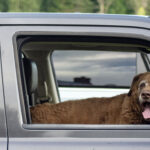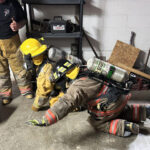AUGUSTA, Maine – With Maine heading into several more days of high temperatures and humidity, it is important for all of us to prevent heat-related problems and to recognize the signs of heat illness early, said Dr. Dora Anne Mills, director of the Maine Center for Disease Control and Prevention.
“Heat-related illnesses and deaths are preventable, yet over the past 30 years more people have died in this country from heat than from hurricanes, lightning, tornadoes, floods, and earthquakes combined,” Mills said. “All Mainers should take the simple measures of keeping cool, drinking adequate fluids, and lying low to prevent heat-related illness.”
Mills said that people most susceptible include infants and young children, adults over age 65, people with mental illness and those who are physically ill with chronic illnesses such as heart disease or high blood pressure. She said it’s important for family and friends to check on people at higher risk, especially if they live alone.
High temperatures often contribute to poor air quality, which disproportionately affects people with lung or heart conditions. People may check for any air quality advisories on http://www.maine.gov/dep/air/.
Mills added that summer camp counselors should pay attention to the conditions. “It is important for coaches and counselors to make sure children and youth are given frequent rest breaks and are drinking plenty of fluids,’’ Mills said. “Camp participants should be encouraged to take a fluid or rest break whenever they desire. Strenuous camp activities should also be curtailed because of these unhealthy weather conditions.”
During normal weather, the body’s internal thermostat produces perspiration that evaporates and cools the body. However, during periods of extreme heat and high humidity, evaporation is slowed and the body must work extra hard to maintain a normal temperature. If the body cannot cool itself, serious illness can result.
“With heat waves not being as common in Maine as in many other places, we need to pay close attention to these simple measures. Keeping cool, drinking adequate fluids, and lying low as well as recognizing heat-related illnesses early and looking after our neighbors, families, and friends will allow us to stay healthy during heat waves this summer,” Mills said.
Some measures all should consider:
Keep Cool — Use air conditioning to cool down or go to an air-conditioned building such as a store, a library, or a cooling center. If you don’t have air conditioning in your home, open windows and shades on the shady side and close them on the sunny side to try to cool it down. Take a cool shower or bath. Wear loose, lightweight, light-colored clothing to help keep cool. Stay out of the sun as much as possible. Wear sunscreen and a ventilated hat (e.g., straw or mesh) when in the sun, even if it is cloudy. Never leave children, pets or those with special needs in a parked car, even briefly. Temperatures in the car can become dangerous within a few minutes. Even with the windows rolled down two inches, it only takes 10 minutes for the inside of a vehicle to reach deadly temperatures on a hot summer day.
Drink Fluids — Drink more fluids regardless of your activity level. Avoid alcohol, caffeine and sugary drinks, since these actually cause you to lose more body fluid. If you are on fluid restrictions or on diuretics, ask your doctor how much fluids you should drink.
Lie Low — Take regular breaks from any necessary physical activity – at least every hour. Avoid strenuous activity during the hottest part of the day (between 11 a.m. and 4 p.m.).
If you must be out in the heat try to limit your outdoor activity to morning and evening hours. Cut down on exercise. If you must exercise, drink two to four glasses of cool, nonalcoholic fluids each hour. A sports beverage can replace the salt and minerals you lose in sweat. If you are on a low-salt diet, talk with your doctor before drinking a sports beverage. Rest often in shady areas – at least every hour.
Protect yourself from the sun by wearing a wide-brimmed hat (also keeps you cooler) and sunglasses and by putting on sunscreen of SPF 15 or higher (the most effective products say “broad spectrum” or “UVA/UVB protection” on their labels).
Heat stroke occurs when the body is unable to regulate its temperature. Body temperatures can reach dangerous levels. Warning signs include hot, dry, red skin (no sweating), rapid pulse, high body temperature (greater than 105 F), headache, loss of alertness, confusion, rapid and shallow breathing, and unconsciousness or coma. Emergency 9-1-1 should be called immediately. While waiting for assistance, cool the person rapidly with such methods as moving them to a shady or cooler area, using cool water, ice, fans, and loosening their clothing.
Heat exhaustion typically occurs when people over-exert themselves in high heat and humidity. Symptoms include heavy sweating, fainting, vomiting, cold, pale, and clammy skin, dizziness, headache, nausea and weakness. Move the person to a cool place, have them drink fluids and rest, loosen their clothes, and cool them off with water or wet cloths. Heat exhaustion can quickly lead to heat stroke. So, if symptoms worsen or do not improve, get medical help.
Heat cramps are muscle cramps in the abdominal area or extremities (e.g. arms and legs) that often occur in people who sweat a lot during strenuous activity and as a result their muscles lose salt and moisture. Heavy sweating and mild nausea often accompany cramps. Move the person to a cool place to rest, and apply firm pressure to the cramping muscle. The person can also gently stretch the cramped muscle and hold it for 20 seconds, and then gently massage it. Have the person drink some cool beverages such as water or a sports drink. The person should seek medical attention if there is no improvement or if the person has underlying medical problems.
Sunburn damages the skin and causes the skin to become red, painful, and warm after sun exposure. Medical attention should be sought if the sunburn affects an infant or if there is fever, fluid-filled blisters, or severe pain. Otherwise, the person should avoid sun exposure, apply cold compresses or immerse the burned skin in cool water, apply moisturizing lotion to the burn.
Heat rash is a skin irritation caused by excessive sweating during hot humid weather and is most common in young children. The rash looks like a red cluster of pimples or small blisters and is most common in the neck and upper chest and in creases such as in the elbow and groin. Move the person to a cooler place and keep the affected area dry. The person can also use talcum powder to increase comfort.







